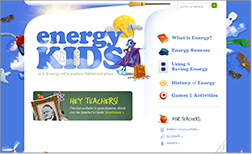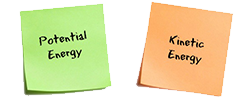
|
|
A Multitude of Media
|
|
The Energy Kids website (maintained by the U.S. Energy Information Administration) is a great resource for exploring energy further. There are great resources available on the site to learn more about how we use energy and ways that we can save energy, both at home and also on the road, at work, and in how consumable goods are produced. The site also provides a detailed history of energy through timelines illustrating the rise (and sometimes fall) of different fuel sources, alongside famous historical figures that moved the nation or the world forward in terms of how we use or conserve energy. But one of the most stand-out features of the site are the science fair experiments that support learning and inquiry of various energy-related concepts. The experiments are organized by grade level groupings (primary, elementary, intermediate, and secondary) and each of the experiment write-ups was developed as a result of the National Energy Education Development Project. What's more, the experiments use household items and the procedure breakdowns are clear and easy to follow.
|

|

|
|
|
|

|
|
Project Idea
|
|
Energy is everywhere, but it's not always the first thing we think when we look around. Using a stack of index cards and some markers, go on an energy scavenger hunt around your classroom or library and label all of the different ways we can observe energy in your space. All energy can be identified as either potential (stored) or kinetic (in motion). Use two different colored index cards or markers to label those objects identified as having potential energy and those modeling kinetic energy. Go deeper by identifying the specific form energy takes in the labeled object. For items demonstrating potential energy, these forms will include chemical energy (such as batteries), mechanical energy (such as a stretched rubber band or the spring in a stapler), and gravitational energy (which is determined by the height with which an object is stored). For items demonstrating kinetic energy, these forms will include radiant energy (such as lights), thermal energy (such as heating vents), motion energy (such as a swinging door), electrical energy (which is anything requiring electricity for power), and sound. The more labels, the more reminders of energy's constant presence in the things around us.
|

|
|
|
|

|
|
e-news Archive
|
|
Get more tips and tools from our past newsletters.
|

|
|
|
|

|
|
Matthew's Tip of the Month
|
 While this may be a time when students can't sit still in your classroom with the anticipation of the coming break, I'd like to share with you a practice one of my colleagues recently showed me that's transformed our classroom community. While this may be a time when students can't sit still in your classroom with the anticipation of the coming break, I'd like to share with you a practice one of my colleagues recently showed me that's transformed our classroom community.
Invite your students to join you in a circle on a carpeted area of your room. Invite students to a minute of silence when they can close their eyes and focus on breathing slow breaths in, then out. Once all students have opened their eyes, ask students to consider their readiness for learning in this moment in terms of a number from 1 to 5.
-
If they feel distracted and unable to concentrate on what's going on in class, they identify as a 1.
-
If they are focused and ready for directions, they identify as 5.
Of course, any number along the spectrum can be shared and the space should be established as safe and judgment free for the students who choose to share. What you will find is that not only will students reveal that they may be distracted because of events that happened earlier in the day or outside of school, but also that, having a chance to be heard and recognized, it will become much, much easier to move forward with learning. It's a simple act and it brings the class's energy into focus and harmony.
|
- Matthew Winner -
Library Media Specialist & TrueFlix Ambassador
|

|
|
|
|

|
|
UPCOMING WEBINAR DATES
|
|
Learn more about getting the most out of TrueFlix by attending one of our monthly online training sessions.
|
Tuesday, January 10th 2017
3:00 to 4:00 pm EST
|

|
Thursday, March 9, 2017
5:00 to 6:00 pm EST
|

|
Tuesday, May 9, 2017
12:00 to 1:00 pm EST
|

|
|
|
|
|
|
We'd Love to Hear From You!
|
|
Have a suggestion for what unit we should cover next? Or have an idea on how we can make this newsletter even better? Whatever it is, we're looking forward to hearing from you.
|

|
|
|
|
|

|
|